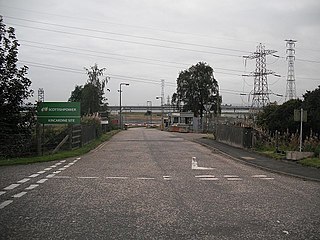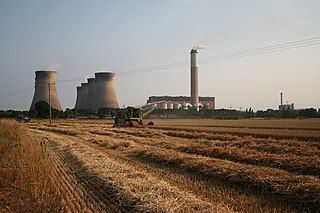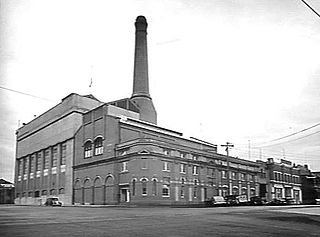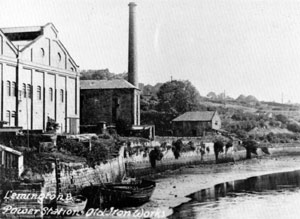
Bankside Power Station is a decommissioned electricity generating station located on the south bank of the River Thames, in the Bankside area of the Borough of Southwark, London. It generated electricity from 1891 to 1981. It was also used as a training base for electrical and mechanical student apprenticeships from all over the country. Since 2000 the building has been used to house the Tate Modern art museum and gallery.

Northern Ireland Electricity Networks Limited (NIE Networks) is the electricity asset owner of the transmission and distribution infrastructure in Northern Ireland, established in 1993 when the business was privatised. NIE Networks does not generate or supply electricity. Since 2010 it has been a subsidiary of ESB Group.

Kincardine power station was a 760 MW coal-fired power station on the shores of the upper Firth of Forth by Kincardine on Forth, Fife, Scotland.

Cottam power station is a decommissioned coal-fired power station. The site extends over 620 acres of mainly arable land and is situated at the eastern edge of Nottinghamshire on the west bank of the River Trent at Cottam near Retford. The larger coal-fired station, was decommissioned by EDF Energy in 2019 in line with the UK's goal to meet its zero-coal power generation by 2025. The smaller in-use station is Cottam Development Centre, a combined cycle gas turbine plant commissioned in 1999, with a generating capacity of 400 MW. This plant is owned by Uniper.

The city of Geelong, Victoria, Australia was once home to two coal fueled power stations - Geelong A and Geelong B.

Lemington Power Station was a small, now demolished coal-fired power station, located in North East England. It was situated on the Lemington Gut, a backwater of the River Tyne, at Lemington, 3.5 mi (5.6 km) west of Newcastle upon Tyne. The station's main building stood until 2017 as a rare example of an early power station, dating from before the nationalisation of the United Kingdom's electrical supply industry.

Shoreham Power Station is a 420MWe combined cycle gas-fired power station in Southwick, West Sussex. It was built on the site of the Brighton B Power Station. Predating both the former Brighton A & B stations, the town of Brighton has a long history of association with the electricity supply industry.

Carville Power Station refers to a pair of now partially demolished coal-fired power stations, situated in North East England on the north bank of the River Tyne at Wallsend. The two stations were built alongside each other on a riverside site about 5 mi (8.0 km) downstream of Newcastle upon Tyne. Carville A Power Station, the first station on the site was opened in 1904, and Carville B Power Station was opened in 1916 to its south.
Neptune Bank Power Station was a coal-fired power station situated on the River Tyne at Wallsend near Newcastle upon Tyne. Commissioned in 1901 by the Newcastle upon Tyne Electric Supply Company, the station was the first in the world to provide electricity for purposes other than domestic and street lighting. It was also the first in the world to generate electricity using three-phase electrical power distribution at a voltage of 5,500 volts.
Carrington Power Station is a combined cycle gas turbine power station, which was completed in Autumn 2016 and began commercial operation on 18 September 2016. It is located on the site of a former coal-fired power station, close to the villages of Carrington and Partington in the Greater Manchester Area and 12 km (7.5 mi) southwest of Manchester City Centre. The Manchester Ship Canal and the River Mersey run alongside the site, in Trafford, Greater Manchester, in North West England.
Close Power Station was a coal-fired power station situated on Newcastle upon Tyne's Quayside, in modern Tyne and Wear. The station was built by the Newcastle and District Electric Lighting Company in 1902, near their Forth Banks Power Station.
The St. Pancras Power Stations were two electricity generating stations, also known as the Regent’s Park Power Station and the King’s Road Power Station, which supplied electricity to the district of St. Pancras in north London from 1891 to 1968.
The Worcester Power Stations were a series of hydro-electric and coal-fired generating stations providing electricity to the City of Worcester.
The Charing Cross and Strand Electricity Supply Corporation Limited was a British electricity undertaking. It was incorporated as a public company in 1889 to generate and supply electricity to parts of the City of Westminster, Holborn and later the City of London. From 1925 it worked jointly with other companies as part of the London Power Company. The company was abolished on 31 March 1948 when the British electricity industry was nationalised, and its assets were transferred to the British Electricity Authority and the London Electricity Board. The Charing Cross Corporation's Bow power station continued in operation until 1969.
Ribble Power Station was a coal-fired electricity generating station on the River Ribble in Penwortham near Preston, Lancashire. The station was built by the Corporation of Preston to replace a small privately-run generating station in the town. It supplied electricity to Preston and the surrounding area from 1923 until 1976. The station was expanded with new equipment in 1943–47 which remained in operation until the power station was closed in 1976 and was subsequently demolished.

Leicester power stations are a series of electricity generating stations that have provided electric power to the City of Leicester and the wider area from 1894. The first station, located within Aylestone gas works, supplied electricity for street lighting. The city’s new electric tram system was supplied from 1904 by a station at Lero which operated until 1930. A large coal-fired power station was constructed at Freemans Meadow in 1922 and was operational until 1976. Finally a gas turbine power plant was commissioned in 1976.
The Percival Lane power station in Runcorn was built and operated by the Mersey Power Company Limited. It comprised two stations A and B commissioned in 1921 and 1941. The station supplied electricity to commercial, industrial and domestic users over a wide area of 95 square miles around the River Mersey including Widnes, Ellesmere Port and Runcorn.

The County of London Electric Supply Company Limited was a British electricity undertaking. It was incorporated as a public company in 1891 to generate and supply electricity to parts of south west London and two parishes adjacent to the City of London. It owned and operated power stations at Wandsworth and City Road. From 1925 it cooperated with three other London companies, with the intention of centralising electricity generation in the new, high thermal efficiency, power station at Barking. The company was abolished in March 1948 upon the nationalisation of the British electricity supply industry.
The two Coventry power stations supplied electricity to the county borough of Coventry and the wider Warwickshire area from 1895 to 1976. They were owned and operated by Coventry Corporation until the nationalisation of the British electricity supply industry in 1948. The first power station was established in 1895 off Sandy Lane north of the city centre. A new larger power station was built at Longford / Hawksbury Junction in 1928 and was extended in 1938 and 1941. The Longford station was decommissioned in October 1976.
Reading power station, Berkshire, England supplied electricity to the town of Reading and the surrounding area from 1895 to the 1960s. It was initially owned and operated by the Reading Electric Supply Company Limited, then from 1933 by the Reading Corporation until the nationalisation of the British electricity supply industry in 1948. The power station was redeveloped several times with new equipment replacing retired plant. The station was decommissioned in the late 1960s.












